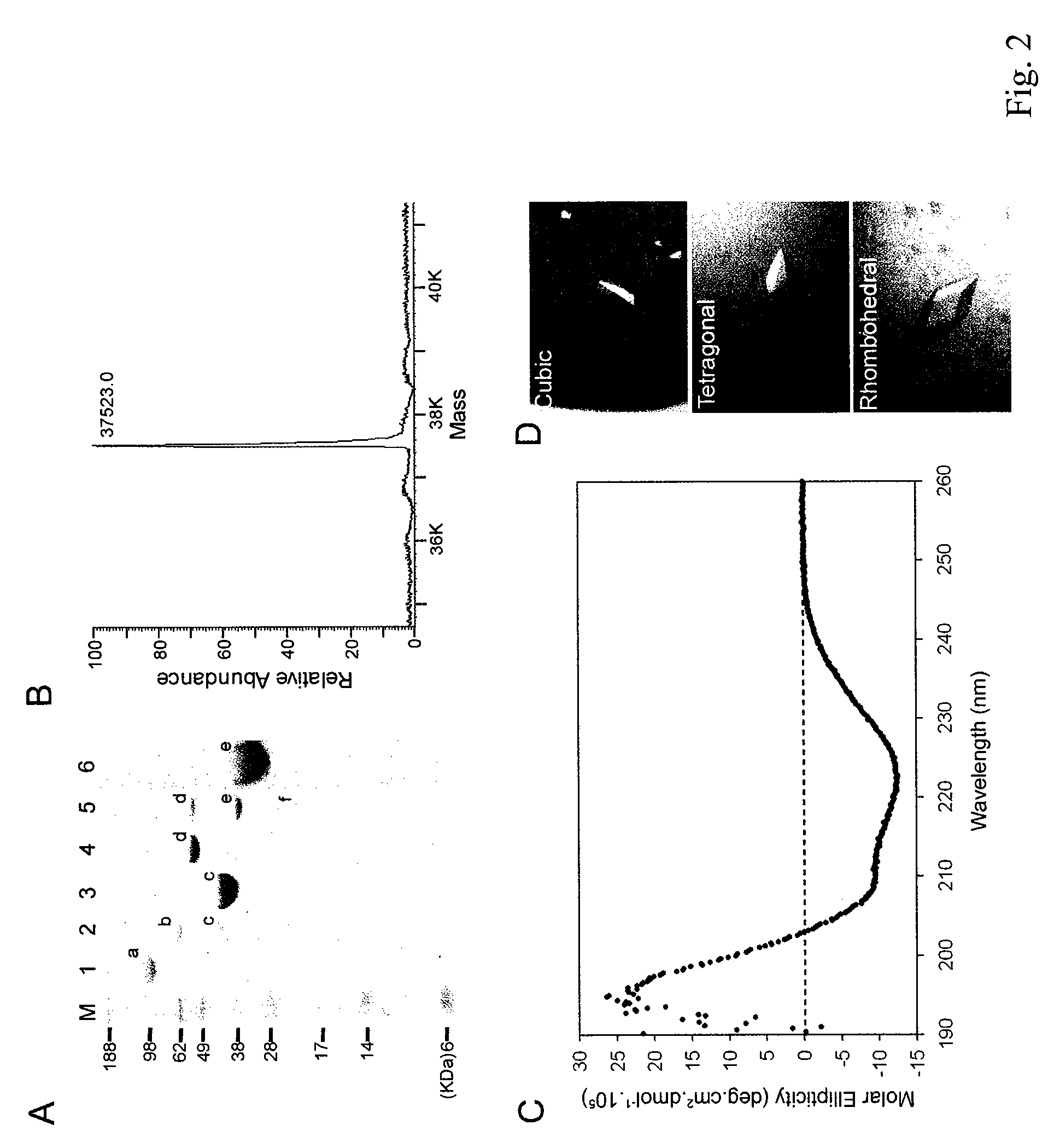Express system of soluble glutaminyl cyclase
a technology expression system, which is applied in the field of expression system of soluble glutaminyl cyclase, can solve the problems of insolubility, low recovery, heterogeneity of protein expression,
- Summary
- Abstract
- Description
- Claims
- Application Information
AI Technical Summary
Problems solved by technology
Method used
Image
Examples
example 1
Construction of Expression Vectors
[0071] Using the primers, 5′-GGCTGGGAGAGATGGCAGGCGGAA-3′ and 5′-GGATAGATGTTTCCACACAGCATT-3′, which are referred to as the 5′- and 3′-noncoding regions of human pituitary QC, respectively, the human QC cDNA was amplified from a commercial bone marrow cDNA library (Clontech, Palo Alto, Calif.) by polymerase chain reaction (PCR). The DNA fragment on the PCR product corresponding to the coding region of human QC (Ala33-Leu361) was re-amplified and inserted into a pET-43.1a expression vector (Novagen, Madison, Wis.) via EcoR I and Xho I cloning sites. A protein cleavage site, such as thrombin cleavage site (TCS), was introduced upstream of the sequence encoding human QC to facilitate protein purification by protein cleavage. The resulting construct, as shown in FIG. 1A, contains two (His)6-tags at the N- and C-terminal sites of human QC. In addition, a pET-32a-based vector was constructed, shown in FIG. 1B. With the initial PCR product as a template, a ...
example 2
Protein Expression and Purification
[0072] The constructed expression vectors were transformed into E. coli BL21 (DE3) cells (Novagen, Madison, Wis.). The bacteria were grown in LB media containing 200 μg / ml ampicillin at 37° C. until a cell density of 0.6 to 0.8 OD600 was reached. The cultures were induced with 1 mM isopropyl-β-D-thiogalactopyranoside (IPTG) for 2 or 4 days at 20° C. The cells were harvested by centrifugation at 6000 rpm, followed by freezing at −80° C.
[0073] In the case of pET 43.1a-based vector, the frozen bacterial pellet was resuspended in buffer A (300 mM NaCl and 10 mM imidazole in 50 mM sodium phosphate, pH 8.0) and lysed by French Press. The lysate was clarified by centrifugation at 22000 revolution per minutes (rpm) for 1 hour and then loaded onto a Ni-NTA (Amersham Pharmacia, Uppsala, Sweden) column pre-equilibrated with buffer A. After the column was washed with buffer A, the Nus-fusion QCs were eluted by a linear gradient of 0 to 100% buffer B (similar...
example 3
Mass Spectrometry Analysis
[0077] Mass spectrometry analysis was carried out on a Finnigan LCQ™ ion trap mass spectrometry (ThermoFinnigan, San Jose, Calif.) with electrospray ionization (ESI) interface. The ESI source was operated in positive ion mode. Sample solution was infused using an HPLC pump with loop injection. ESI operation conditions involved a spray voltage of 4.5 kV, a heated capillary temperature of 160° C., and a flow rate of 50 μl / min. The mass spectrometer was operated in full-scan profile mode, scan range from mass-to-charge (m / z) of 150 to 2000. Data acquisition and analysis were performed with Xcalibur (version 1.3, ThermoFinnigan, San Jose, Calif.) and BioWorks™ 3.0 (ThermoFinnigan, San Jose, Calif.).
[0078] As shown in FIG. 2B, mass spectrometry analysis revealed that the mature human QC had a molecular weight of 37523.0, which is consistent with the predicted molecular mass of 37515.5.
PUM
| Property | Measurement | Unit |
|---|---|---|
| Fraction | aaaaa | aaaaa |
| Fraction | aaaaa | aaaaa |
| Molar density | aaaaa | aaaaa |
Abstract
Description
Claims
Application Information
 Login to View More
Login to View More - R&D
- Intellectual Property
- Life Sciences
- Materials
- Tech Scout
- Unparalleled Data Quality
- Higher Quality Content
- 60% Fewer Hallucinations
Browse by: Latest US Patents, China's latest patents, Technical Efficacy Thesaurus, Application Domain, Technology Topic, Popular Technical Reports.
© 2025 PatSnap. All rights reserved.Legal|Privacy policy|Modern Slavery Act Transparency Statement|Sitemap|About US| Contact US: help@patsnap.com



